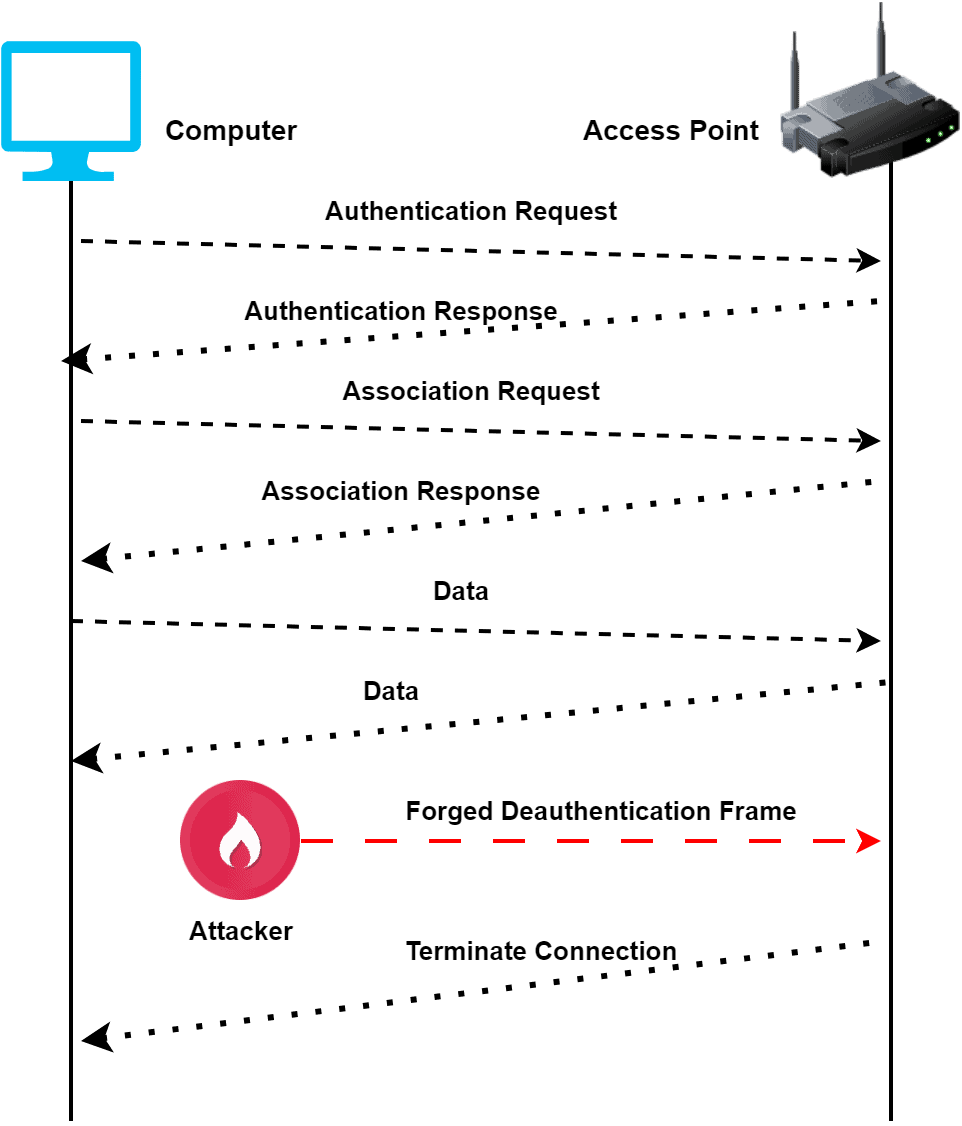1. Overview
In this tutorial, we’ll introduce wireless disassociation attacks. We’ll present how attackers can launch such attacks and what are the possible impacts of such attacks.
Finally, we’ll highlight some mitigation techniques to minimize the impact of wireless disassociation attacks.
2. Introduction
Wireless disassociation attacks, also known as deauthentication attacks, are wireless network attacks that target the 802.11 Wi-Fi protocol. The attack involves sending forged deauthentication frames to a wireless access point or client device, causing the device to disconnect from the network.
The purpose of a wireless disassociation attack is to disrupt the regular operation of a wireless network by causing clients to lose connectivity. It can launch other attacks, such as man-in-the-middle attacks, or steal sensitive information.
Wireless disassociation attacks can be carried out using specialized tools or custom scripts. The attacker needs access to the wireless network and the capability to send deauthentication frames.
3. Steps Involved
Let’s explore how wireless disassociation attacks work in detail. Generally, these attacks work by sending forged deauthentication frames to a wireless access point or client device. These frames mimic legitimate deauthentication frames, which the Wi-Fi protocol uses to disconnect devices from the network.
Generally, an attacker implements such attacks in four steps:

The attack starts with the attacker monitoring the target’s wireless network. The attacker can either passively listen for traffic or actively probe the network. Once the attacker identifies a client device or access point they want to disconnect, they send a series of forged deauthentication frames to the target device.
These frames contain the MAC addresses of the attacker and the target device. Additionally, frames include a reason code that indicates the reason why a device should be disconnected from the network. The reason code could be anything, but it’s commonly set to 0x0004. This value refers to the message: deauthentication due to inactivity.
When the target device receives the forged deauthentication frames, it assumes they’re legitimate and disconnects from the network. At this stage, the client device may attempt to reconnect to the network.
However, the attacker keeps sending deauthentication frames, preventing the device from reconnecting. Additionally, the attacker may also use a jamming technique to disrupt the Wi-Fi signal and prevent the device from connecting to the network. Finally, the attacker can launch network attacks on the targeted devices until it achieves its goal.
Let’s look at a diagram that depicts the whole process of a wireless disassociation attack:

The success of a wireless disassociation attack depends on several factors, including the proximity of the attacker to the target device, the strength of the wireless signal, and the security measures in place on the wireless network.
4. Impact
The impact of a wireless disassociation attack can be significant, as it can disrupt the normal operation of a wireless network. Let’s discuss some potential impacts of a successful wireless disassociation attack.
These attacks can result in a denial of service (DoS) for the target device or the entire wireless network. It can prevent users from accessing critical resources or cause business operations to halt.
A wireless disassociation attack can cause instability in the network by disconnecting devices from the network. As a result, we can see connectivity issues and degradation of network performance, affecting productivity and user experience.
If the attacker launches an attack against a device that is in the middle of a data transfer, the attack can cause data loss or corruption.
In some cases, attackers use wireless disassociation attacks to deliver malware to the target device. By disconnecting the device from the network, the attacker can create an opportunity to deliver malicious code.
Overall, the impact of a wireless disassociation attack can vary depending on the target device and the security measures in place on the wireless network. Network administrators and users must be aware of the risks as well as take appropriate measures to protect against these attacks.
5. Mitigation Techniques
We can use several mitigation techniques to protect against wireless disassociation attacks. Let’s discuss some popular and widely used mitigation methods.
We can use WPA2 encryption on the wireless network to prevent attackers from intercepting and manipulating wireless traffic. It provides strong encryption and authentication, making it difficult for attackers to launch successful wireless disassociation attacks.
Another useful method is network segmentation. Segmenting the wireless network into separate virtual networks can limit the impact of a successful wireless disassociation attack. We can minimize the effects of attacks by isolating critical resources, such as servers or financial systems, from the rest of the network.
In order to reduce wireless disassociation attacks, we can utilize wireless intrusion detection systems (WIDS). Deploying WIDS solutions can detect abnormal wireless activity, including wireless disassociation attacks. These systems can alert network administrators to potential attacks and provide real-time threat intelligence.
Finally, we need to update firmware and patches regularly. Keeping wireless access points and client devices updated with the latest firmware and security patches can provide efficient protection against known vulnerabilities that can be exploited in wireless disassociation attacks.
By implementing these mitigation techniques, network administrators and users can reduce the risk of successful wireless disassociation attacks. Hence, mitigation techniques enhance the overall security of the wireless network.
6. Conclusion
In this tutorial, we discussed how an attacker could launch wireless disassociation attacks on devices connected to a network. We highlighted the possible impact on the network and the connected devices with such attacks.
Finally, we presented some mitigation techniques to protect devices and networks against such attacks.